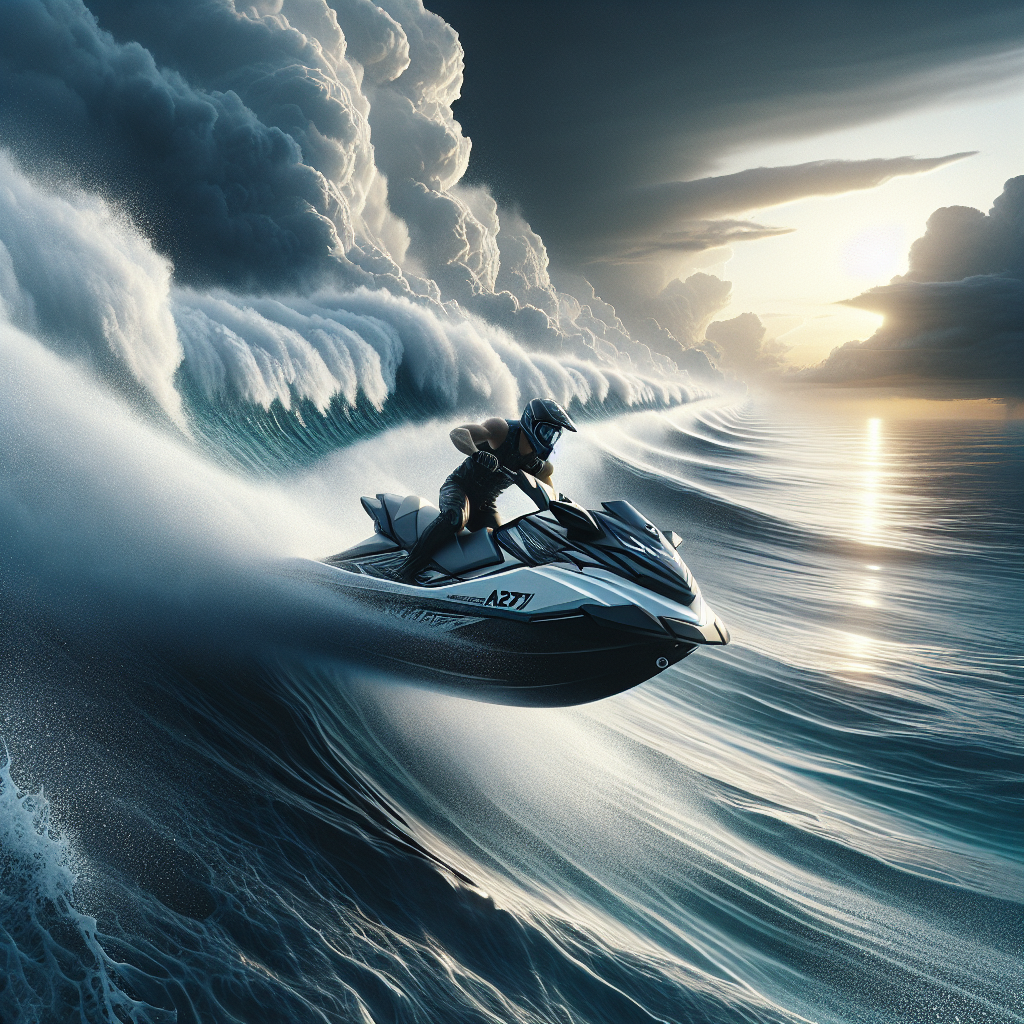Experience the Thrill of Riding in Different Water Conditions with A2Z Powersport

Experience the thrill of riding in different water conditions with A2Z Powersport. If you’re a jet skier looking for the ultimate adventure, look no further! A2Z Powersport, the watersport experts located in Orange Beach, AL, offer the perfect solution for your water riding needs. Whether you prefer calm and serene waters or crave the adrenaline rush of challenging waves, they have it all. With their top-notch jet skis available for rent, you can immerse yourself in the excitement of riding the waves while enjoying the beautiful surroundings. Don’t miss out on this incredible opportunity, contact A2Z Powersport today at (954) 296 1862 or email bookings@a2zpowersport.com to make your booking and experience the thrill of riding in different water conditions.
Water Conditions and Jet Skiing
Jet skiing is a thrilling water sport that allows you to experience the adrenaline rush of riding on the water. However, it is important to understand the impact of water conditions on your jet skiing experience. Assessing water conditions before hitting the waves is crucial to ensure your safety and enhance your enjoyment. In this article, we will explore the different types of water conditions you may encounter while jet skiing and provide tips on how to prepare for each scenario. Whether you’re riding in calm waters, choppy waters, rough seas, waves and swells, windy conditions, or currents and tides, we’ve got you covered!
Preparing for Different Water Conditions
Before you embark on your jet skiing adventure, it is essential to prepare for the different water conditions you may encounter. Here are some tips to help you get ready:
1. Checking Weather Reports and Forecasts
One of the easiest ways to assess water conditions is by checking weather reports and forecasts. Websites, smartphone apps, and local news channels provide valuable information about wind speed, wave heights, and other relevant factors. Always plan your jet skiing trip according to the weather conditions to ensure your safety and enjoyment.
2. Using Personal Watercraft (PWC) Apps
In addition to weather reports, there are also personal watercraft (PWC) apps available that can give you real-time information about water conditions. These apps provide useful data such as wind direction, water temperature, and tide times. By using these apps, you can stay updated on the current water conditions at your location.
3. Carrying Essential Safety Equipment
No matter the water conditions, it is crucial to prioritize safety while jet skiing. Make sure you have all the essential safety equipment, including a life jacket, whistle, and fire extinguisher. These items can be life-saving in case of emergencies and are necessary for a safe and enjoyable ride.
Riding in Calm Waters
Calm water conditions are ideal for beginners as they offer a smooth and relaxing ride. Here’s what you need to know about riding in calm waters:
Characteristics of Calm Water Conditions
Calm waters refer to a lack of strong winds or waves. These conditions are often found in lakes, reservoirs, and sheltered areas. Calm waters are perfect for cruising, sightseeing, and practicing your jet skiing skills.
Enjoying a Smooth and Relaxing Ride
When riding in calm waters, you can expect a smooth and relaxing experience. The absence of strong winds and waves allows for easy navigation and maneuverability. This is a great opportunity to enjoy the scenery, soak up the sun, and appreciate the tranquility of the water.
Tips for Maximizing the Experience
To maximize your experience in calm waters, consider trying out different tricks and maneuvers. Practice sharp turns, figure eights, and even jumps if you feel confident. Remember to always ride within your skill level and never exceed the recommended speed limits. Additionally, take advantage of the calm conditions to work on your balance and control, as these skills will come in handy in more challenging water conditions.
Riding in Choppy Waters
Choppy water conditions can pose challenges for jet skiers, but with the right techniques, you can still have an enjoyable ride. Here’s what you need to know about riding in choppy waters:
Characteristics of Choppy Water Conditions
Choppy waters are characterized by small, irregular waves caused by wind and boat traffic. These conditions can make steering and maintaining balance more difficult. Coastlines, bays, and areas with high boat traffic are more likely to have choppy waters.
Challenges Faced While Riding
When riding in choppy waters, you may face challenges such as reduced stability and increased bouncing. It can be harder to maintain control of your jet ski and navigate through the waves. It is important to stay focused and be prepared for sudden changes in direction and speed.
Techniques for Handling Choppy Waters
To handle choppy waters effectively, you should adjust your riding technique. Lean forward to keep your weight centered and maintain stability. Use your legs as shock absorbers to absorb the impact of the waves. Also, remember to maintain a constant speed to help stabilize your jet ski. By practicing these techniques, you can navigate through choppy waters with confidence and enjoy a thrilling ride.
Riding in Rough Seas
Rough seas pose greater challenges and require advanced skills and precautions. Here’s what you need to know about riding in rough seas:
Characteristics of Rough Seas
Rough seas are characterized by larger waves and strong currents. These conditions are often found in open waters, especially during storms or high winds. Riding in rough seas requires experience and expertise due to the increased risk of capsizing or being thrown off your jet ski.
Safety Considerations and Precautions
Safety should always be the top priority when riding in rough seas. Make sure you are wearing a sturdy life jacket and are familiar with the safety procedures. It is advisable to ride with a partner and establish a communication system to ensure assistance is available if needed. Additionally, always check the weather conditions and wave height before venturing into rough seas. If the conditions seem unsafe, it’s best to postpone your ride for another day.
Expert Tips for Riding in Rough Seas
If you are an experienced rider and choose to ride in rough seas, here are some expert tips to keep in mind:
- Maintain a strong grip on the handlebars and keep your body low and centered to maintain stability.
- Look ahead and anticipate the waves. Adjust your speed and direction accordingly to navigate through the waves and avoid collision.
- Use the throttle wisely. Avoid sudden acceleration or deceleration, as it can destabilize your jet ski in rough seas.
- Keep a safe distance from other riders and boats. The increased water movement and reduced visibility can make it harder to spot obstacles.
- Be mindful of fatigue. Riding in rough seas can be physically demanding, so take breaks when needed to rest and hydrate.
Riding in Waves and Swells
If you’re seeking an exhilarating experience, riding waves and swells can offer the perfect opportunity. Here’s what you need to know about riding in waves and swells:
Understanding Wave and Swell Patterns
Waves and swells are the result of energy transfer from the wind to the water surface. Waves are usually formed by local wind conditions, while swells are generated by distant storms. Understanding the patterns and behavior of waves and swells is crucial when riding them.
Navigating and Riding Waves
To successfully navigate and ride waves, it is important to maintain balance and control. As a wave approaches, accelerate to match its speed and lean forward to maintain stability. As you ride the wave, adjust your riding technique to ensure a smooth and controlled descent. Always be aware of other riders and boats around you to avoid collisions.
Advanced Techniques for Masters of Wave Riding
For experienced riders looking to master wave riding, here are some advanced techniques to consider:
- Timing is key. Learn to anticipate the waves and position yourself accordingly.
- Use your body weight to control the direction of the jet ski as you ride the wave. Leaning forward or backward can help you adjust your trajectory.
- Experiment with different angles and positions on the wave to find the most exhilarating and controlled ride.
- Practice wave jumping by approaching the wave at an angle and using the upward momentum to perform jumps and tricks. However, ensure you have sufficient skill and experience before attempting this.
Riding in Windy Conditions
Windy conditions can add an exciting challenge to your jet skiing experience. Here’s what you need to know about riding in windy conditions:
Impact of Wind on Jet Skiing
Strong winds can significantly impact your jet skiing experience. They can create larger waves, strong currents, and gusts that affect balance and control. Riding in windy conditions requires extra caution and adaptation.
Maintaining Control in Windy Conditions
To maintain control in windy conditions, it is important to:
- Lower your speed to maintain stability and enhance maneuverability.
- Ride into the wind when starting your ride and return with the wind at your back to reduce the impact of gusts.
- Be prepared for sudden changes in wind direction and adjust your riding technique accordingly.
- Brace yourself for stronger waves and currents and be conscious of their impact on your balance.
Tips for a Safe and Enjoyable Ride
In windy conditions, it is crucial to stay alert and ensure your safety. Consider the following tips for a safe and enjoyable ride:
- Dress appropriately by wearing a windproof wetsuit or jacket to protect yourself from the wind chill.
- Use caution when riding in crosswinds, as they can cause instability. Adjust your body position and lean into the wind to maintain balance.
- Be mindful of changing weather conditions. If the wind becomes too strong, it may be wise to cut your ride short and return to shore.
- Keep an eye on your fuel consumption, as riding against strong winds can consume more fuel than usual. Ensure you have enough fuel for your planned ride.
Riding in Currents and Tides
Currents and tides can significantly affect your jet skiing experience, especially in coastal areas. Here’s what you need to know about riding in currents and tides:
Effects of Currents and Tides on Jet Skiing
Currents and tides can create strong water movements and affect your navigation and control. It is crucial to understand their behavior and take necessary precautions.
Navigating Strong Currents
When riding in areas with strong currents, it is important to navigate with caution. Be aware of the direction and speed of the current to adjust your ride accordingly. Riding parallel to the current can help you maintain control and reduce the risk of being carried away.
Strategies for Dealing with Changing Tides
Changing tides can affect water depths and expose potential hazards. Make sure you are familiar with the tidal patterns and plan your ride accordingly. Riding during high tide can provide more water depth and room to maneuver, while riding during low tide requires awareness of potential shallow areas. Always ride within the safe limits of the current tide conditions.
Riding in Saltwater and Freshwater
Jet skiing can be enjoyed in both saltwater and freshwater, but there are key differences between the two. Here’s what you need to know:
Differences Between Riding in Saltwater and Freshwater
Saltwater and freshwater have different buoyancy levels, salt concentration, and potential hazards. In saltwater, the buoyancy is greater, which can provide a smoother ride and greater stability. However, the salt concentration in saltwater can corrode your jet ski if not properly maintained. Freshwater may have less buoyancy, but it poses less risk of corrosion.
Tips for Maintaining Your Jet Ski in Saltwater
If you plan to ride in saltwater, it is important to take extra care in maintaining your jet ski. Rinse your jet ski thoroughly with fresh water after each ride to remove any salt residue. Additionally, apply a protective wax to the exterior and regularly check for any signs of corrosion. Proper maintenance will extend the lifespan of your jet ski.
Considerations for Jet Skiing in Freshwater
While freshwater may have its advantages, it is important to consider potential hazards such as submerged rocks, shallow areas, and vegetation. Familiarize yourself with the body of water you plan to ride in and be cautious of any hidden obstacles. Always adhere to safety guidelines to prevent accidents and damage to your equipment.
Experience the Thrill with A2Z Powersport
For the ultimate jet skiing experience, consider renting your jet ski from the watersport experts at A2Z Powersport. Located in Orange Beach AL at the Fort Morgan Marina, A2Z Powersport offers a range of jet ski rentals to suit all skill levels. With their expertise and knowledge of local water conditions, you can trust them to provide you with the best equipment and safety precautions.
Contact A2Z Powersport at 1577 AL-180 W, Orange Beach, AL 36542, or call (954) 296 1862 to book your jet ski rental. You can also reach them via email at bookings@a2zpowersport.com. Experience the thrill of riding in different water conditions with the professionals at A2Z Powersport!
In conclusion, riding in different water conditions brings unique challenges and experiences for jet skiers. By understanding the characteristics of each water condition and following the appropriate techniques and safety precautions, you can have a safe and enjoyable ride. So, whether you prefer calm waters, choppy waves, rough seas, or exhilarating swells, use this guide to enhance your jet skiing adventures and create unforgettable memories.










